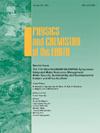Spectral decomposition’ application images early-Cretaceous tectonically-controlled shallow-marine unconventional shale gas-bearing resources, SW-Asian Indus rift basin: Inverted velocity and density structural simulations
IF 3
3区 地球科学
Q2 GEOSCIENCES, MULTIDISCIPLINARY
引用次数: 0
Abstract
Incised marine valleys (IV) are hot topics in unconventional shale gas exploration. These depositional systems are developed during the rapid fall and subsequent slow rise in the sea level. The reservoir shale lenses are trapped in the naturally fractured shale facies of IV. Therefore, the natural fractures and fault systems inside this IV have an enormous impact on the perpendicular and horizontal movement of hydrocarbon-posture fluids. Every combination trap of a petroleum system has an exact fine-tuning frequency, which can remain useable for resolving the reservoir and seal. This study develops a cost-economic petroleum system using seismic attributes, broadband spectral decomposition-based inverted density structural simulation and inverted velocity structural simulation for imaging natural fractures and fault systems in the SW-Asian onshore Indus rift basin. A band-pass frequency filter of 6–22-48-62 Hz was applied on the IV with two lower-peak and higher-peak tuning frequencies of 22-Hz and 48-Hz. The 22-Hz tuning frequency resolves this IV architecture at its greatest plausible location of gas-posture reserves. The traditional mapping shows poor competence to image a fractured system. The 22-Hz frequency has resolved the dense fracture system in the westernmost region. 48-Hz frequency has resolved the top seal of fracture-less zones to provide high-density zones to stop vertical migrations of gas-bearing fluids inside the reservoir shale lenses of IV. The inverted velocity structural simulations have poorly imaged the E-W transforms fault. The 22-Hz frequency-based inverted density structural simulations have resolved the en-echelon geometry along a high-amplitude anomalous and E-W oriented transform fault from a point of inflexion of fractured reservoir shale lenses from source to reservoir beds of IV. The lateral extent of this en-echelon structure is ∼1.35 km with a vertical depth of ∼3281–3299 m. The inverted density structural simulation has resolved two transform faults, which were imaged at depths of 3282 and 3298 m. The zone between pseudo-densities of 2.1–2.4 g/c.c shows uniform sedimentations inside the IV. This implicates the deposition of laterally continuous and fractured fluvial-dominated reservoir shale reservoir lenses. The inverted density structural simulations have also resolved the least angle (<∼2o) of the combination trap at pseudo-densities of 2.1–2.4 gm./c.c. No vertical amplitude anomaly could be imaged for predicting the intensity of fractures and upward migration from source to reservoir beds, which implicates the regionally established traps inside the IV. The fractured reservoir has accumulated the shale gas-bearing fluids inside the IV, which implicates the tectonic subsidence. The combination trap experiences inclinations increase to 35o at a 2.6 gm./c.c pseudo-density. Hence, inverted density structural simulation shows strong implications for the horizontal migrations of shale gas resources inside the IV. Consequently, conducted exploration strategies may serve as an analogue for the SW-Asian Indus Onshore rift basin and similar structural basins.

西南亚印度河断陷盆地早白垩世构造控制下浅海非常规页岩气资源光谱分解应用图像:速度与密度逆构造模拟
海相裂谷(IV)是非常规页岩气勘探的热点。这些沉积体系是在海平面快速下降和随后缓慢上升的过程中形成的。储层页岩透镜体被圈闭在四段天然裂缝页岩相中,因此四段内的天然裂缝和断裂体系对油气位流体的垂直和水平运移具有巨大的影响。油气系统的每个组合圈闭都有一个精确的微调频率,可以用于确定储层和密封。本研究利用地震属性、基于宽带频谱分解的反向密度结构模拟和反向速度结构模拟,开发了一种成本经济的石油系统,用于对西南亚陆上印度河裂谷盆地的天然裂缝和断裂系统进行成像。采用6-22-48-62 Hz的带通频率滤波器,调谐频率分别为22 Hz和48 Hz。22赫兹的调谐频率解决了这个IV架构在其最大的似是而非的位置的气体姿态储备。传统的测绘方法对裂缝系统的成像能力较差。22hz的频率解决了最西端地区致密的裂缝系统。48hz频率解决了无缝带的顶部密封,提供高密度区域,以阻止IV层储层页岩透镜体内含气流体的垂直运移。反向速度构造模拟对E-W转换断层的成像较差。基于22 hz频率的反向密度构造模拟解决了从裂缝性储层页岩透镜体拐点从源到储层沿高振幅异常和E-W向转换断层的几何形状。该梯队结构的横向范围为~ 1.35 km,垂直深度为~ 3281-3299 m。反向密度构造模拟解决了两条转换断层,分别在3282和3298 m深度成像。伪密度介于2.1 ~ 2.4 g/c之间,表明IV组内部沉积均匀,暗示其为横向连续、裂缝型河流主导储层页岩储层透镜体沉积。反向密度结构模拟也解决了组合陷阱在2.1-2.4 gm./c.c伪密度下的最小角(< ~ 20)。垂直幅值异常无法预测裂缝强度及源层向储层向上运移,提示区内存在区域性圈闭。裂缝性储层聚集了含页岩气流体,提示构造沉降。当拟密度为2.6 mg /c.c时,组合陷阱的倾角增加到35°。因此,反向密度构造模拟对页岩气资源的水平运移具有重要意义。因此,所进行的勘探策略可以作为西南印度河陆上裂谷盆地和类似构造盆地的模拟。
本文章由计算机程序翻译,如有差异,请以英文原文为准。
求助全文
约1分钟内获得全文
求助全文
来源期刊

Physics and Chemistry of the Earth
地学-地球科学综合
CiteScore
5.40
自引率
2.70%
发文量
176
审稿时长
31.6 weeks
期刊介绍:
Physics and Chemistry of the Earth is an international interdisciplinary journal for the rapid publication of collections of refereed communications in separate thematic issues, either stemming from scientific meetings, or, especially compiled for the occasion. There is no restriction on the length of articles published in the journal. Physics and Chemistry of the Earth incorporates the separate Parts A, B and C which existed until the end of 2001.
Please note: the Editors are unable to consider submissions that are not invited or linked to a thematic issue. Please do not submit unsolicited papers.
The journal covers the following subject areas:
-Solid Earth and Geodesy:
(geology, geochemistry, tectonophysics, seismology, volcanology, palaeomagnetism and rock magnetism, electromagnetism and potential fields, marine and environmental geosciences as well as geodesy).
-Hydrology, Oceans and Atmosphere:
(hydrology and water resources research, engineering and management, oceanography and oceanic chemistry, shelf, sea, lake and river sciences, meteorology and atmospheric sciences incl. chemistry as well as climatology and glaciology).
-Solar-Terrestrial and Planetary Science:
(solar, heliospheric and solar-planetary sciences, geology, geophysics and atmospheric sciences of planets, satellites and small bodies as well as cosmochemistry and exobiology).
 求助内容:
求助内容: 应助结果提醒方式:
应助结果提醒方式:


